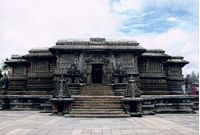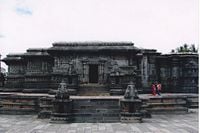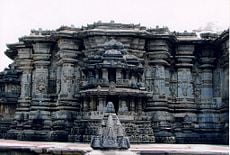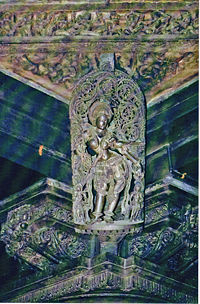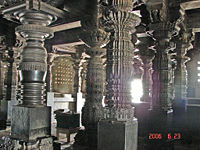Chennakesava Temple
- This article is about Chennakesava Temple in Belur. For other uses of the term, see Chennakesava Temple (disambiguation).
The Chennakesava Temple (Kannada:ಶ್ರೀ ಚೆನ್ನಕೇಶವ ದೇವಸ್ಥಾನ) originally called Vijayanarayana Temple(Kannada: ವಿಜಯನಾರಾಯಣ ದೇವಸ್ಥಾನ) was built on the banks of the Yagachi River in Belur, an early capital of the Hoysala Empire. Belur is 40 km from Hassan city and 220 km from Bangalore, in Hassan district of Karnataka state, India. Chennakesava means "handsome Kesava". Belur is well-known for its marvelous temples built during the rule of Hoysala dynasty. Belur along with near by Halebidu is also one of the most favored tourist destinations in Karnataka. Belur is an important Vaishnava pilgrim centre. Visitors are often humbled by the beauty of the sculptures that are present here which are popular with Hoysala architecture and craftsmanship.
History
- See also: Hoysala architecture , Hoysaleswara temple , and Chennakesava Temple at Somanathapura
The temple was commissioned by Hoysala king Vishnuvardhana in 1117 C.E. Scholars hold their own opinions regarding the reasons for the construction of the temple. The popular belief is the military success of Vishnuvardhana was the reason.[1] Some scholars opine that Vishnuvardhana commissioned the temple to surpass the Hoysala overlords, the Western Chalukyas who ruled from Basavakalyan, after his victories against the Chalukyas[2] while another theory is he was celebrating his famous victory against the Cholas of Tamil country in the battle of Talakad after which the Hoysalas took control of Gangavadi (southern regions of Karnataka).[3] Yet another explanation pertains to Vishnuvardhana's conversion from Jainism to Vaishnavism, considering this is predominantly a Vaishnava temple.[4] The Hoysalas had many brilliant architects who developed a new architectural idiom. A total of 118 inscriptions have been recovered from the temple complex covering a period of 1117 to 18th century which give details of the artists employed, grants made to the temple and renovations.
Temple complex
The main entrance to the complex is crowned by a Rayagopura built during the days of Vijayanagar empire.[5] Within the temple complex, the Chennakesava temple is in the centre, facing east and flanked by Kappe Channigraya temple and a small Lakshmi temple on its right. On its left and to its back is an Andal temple. Of the two main Sthambha (pillar) that exist, the one facing the main temple was built in the Vijayanagar period and the one to the right was from the Hoysala time. While this is the first great Hoysala temple, the artistic idiom is still Western Chalukyan, hence the lack of over decoration unlike in other later Hoysala temples including the Hoysaleswara temple at Halebidu and the Keshava temple at Somanathapura. During later years, the Hoysala art took an inclination towards craftsmanship, with a weakness for minutia.[6] The temple has three entrances and the doorways have highly decorated sculptures of doorkeepers (dvarapalaka). While the Kappe Channigraya temple is smaller than the Chennakesava temple, it is architecturally equally significant but lacks any sculptural features. This became a dvikuta (two shrined) with the addition of a shrine to its original plan. The original shrine has a star shaped plan while the additional shrine is a simple square. The icon inside is also Kesava and was commissioned by Shantala Devi, queen of king Vishnuvardhana.
Temple plan
The Chennakesava temple is built with Chloritic Schist (soapstone)[7] and is essentially a simple Hoysala plan built with extraordinary detail. What differentiates this temple from other Hoysala temples of the same plan is the unusually large size of the basic parts of the temple.[8] The temple is a ekakuta vimana design (single shrine) of 10.5 m by 10.5 m size. A large vestibule connects the shrine to the mandapa (hall) which is one of the main attractions of the temple. The mandapa has 60 bays.[9] The superstructure (tower) on top of the vimana has been lost over time. The temple is built on a jagati (platform).[10] Hence there is one flight of steps leading to the jagati and another flight of steps to the mantapa. The jagati provides the devotee of an opportunity to do a pradakshina (circumambulation) around the temple before entering it. The jagati carefully follows the staggered square design of the mantapa[11] and the star shape of the shrine. The mantapa was originally an open one. A visitor would be able to see the ornate pillars of the open mantapa from the platform. The mantapa is perhaps the most magnificent one in all of medieval India.[12] The open mantapa was converted into a closed one after about 50 years during the Hoysala rule. This was done by erecting walls with pierced window screens. The window screens are on top of 2 m high walls. There are 28 such windows, with star shaped piercing and bands of foliage, figures and mythological subjects. On one such screen, king Vishnuvardhana and his queen Shanatala Devi are depicted. An icon depicts the king in a standing posture.[13]
Shrine
The vimana (shrine) is at the back of the mantapa. Each side of the vimana measures 10.5 m and has five vertical sections: a large double storeyed niche in the centre and two heavy pillar like sections on both sides of that niche. The two pillar like sections adjoining the niche are rotated about their vertical axis to produce a star shaped plan for the shrine.[14] The pillar like section and the niche bear many ornate sculptures, belonging to an early style. There are some 60 large sculptures and are of deities from both Vaishnava and Shaiva faiths. From the shape of the vimana it has been inferred that the tower above would have been of the Bhumija style and not the regular star shaped tower that follows the shape of the vimana. The Bhumija towers are present on the miniature shrines at the entrance of the hall and are actually a type of nagara design (being curvilinear in shape).[15] This shape of tower is quite uncommon in pure dravidian design. The shrine has a life size (about 6 ft) image of Kesava (a form of Vishnu) with four hands, each hand holding an attribute namely, the discus (chakra), mace (gadha), lotus-flower (padma) and conch (Shanka) in clockwise direction. The entrance to the shrine is flanked by life size sculptures of door guardians (dvarapalaka).
Pillars and Sculptures
The pillars inside the hall are a major attraction and the most popular is the Narasimha pillar which at one time is said to have been a revolving one (on its ball bearings).[16] There is a rich diversity about their style. While all the 48 pillars and the many ceilings are well decorated, nothing surpasses the finish of the four central pillars and the central ceiling. These pillars may have been hand churned while the others were lathe turned.[17] All four pillars bear madanikas (celestial nymphs) and there are 42 of them, 4 inside the hall and the rest outside between the eaves on the outer walls of the hall.[18] They are also called madanakai, salabanjika or shilabalika and epitomise the ideal female form. They are depicted as dancers, musicians, drummers etc. and are rarely erotic in nature. Some madanika popular with tourists are the Darpana Sundari (beauty with mirror), "The lady with the parrot", "The huntress" and Bhasma mohini.[19] Other interesting sculptures inside the mantapa are Sthamba buttalika (pillar images) which are more in the Chola idiom indicating that the Hoysalas may have employed Chola craftsman along with locals. These images have less decor than regular Hoysala sculptures. The mohini pillar is an example.[20]
At the base of the outer walls are friezes[21] of charging elephants (650 of them) which symbolise stability and strength, above them are lions which symbolise courage and further up are horses which symbolise speed. There are panels with floral designs signifying beauty. Above these are panels depicting Ramayana and Mahabharata. This is called horizontal treatment with friezes.[22] Hoysala artistry preferred to be discreet about eroticism, mingling miniature erotic sculptures in not very conspicuous places like recesses and niches. Sculptures depict daily life in a broad sense.
The doorways to the mantapa have on both sides the sculpture of Sala slaying a Tiger. These are unusually large images. While Sala is popularly known to be the founder of the empire, there is no support for this myth from scholars. Normally this image is placed on the sukanasi (nose of the main tower formed by a lower tower on top of the vestibule) next to the main tower. The story is that Sala killed the Tiger that was ready to pounce on the meditating muni (saint) who sought Sala's help in killing the Tiger. Some historians speculate that the legend may have gained importance after the victory of Vishnuvardhana over the Cholas at Talakad, the tiger being the royal emblem of the Cholas.[23]
Other important sculptures are the Narasimha image in the south western corner, Shiva-Gajasura (Shiva slaying demon in form of elephant) on the western side, the winged Garuda, consort of Lord Vishnu standing facing the temple, dancing Kali, a seated Ganesha, a pair consisting of a boy with an umbrella and a king (Vamana avatar or incarnation of Vishnu), Ravana shaking Mount Kailash, Durga slaying demon Mahishasura, standing Brahma, Varaha (avatar of Vishnu), Shiva dancing on demon (Andhakasura), Bhairava (avatar of Shiva) and Surya. The sculptural style of the wall images shows close similarity to wall images in contemporary temples in northern Karnataka and adjacent Maharashtra and hence a Western Chalukya idiom.
Artists
The Hoysala artists were unlike many medieval artists and preferred to sign their work in the form of inscriptions. They sometimes revealed fascinating details about themselves, their families, guilds and place of origin.[24] Stone and copper plate inscriptions provide more information about them. Ruvari Mallitamma was a prolific artist and there are more then 40 sculptures here that are attributed to him.[25] Dasoja and his son Chavana were from Balligavi in Shimoga district and contributions are no less. Chavana is credited with the work on five madanika and Dasoja with four. Malliyanna and Nagoja created birds and animals in their sculptures. Artists Chikkahampa and Malloja are credited with some the sculptures in the mantapa.[26]
Notes
- ↑ Gerard Foekema, A Complete Guide to Hoysala Temples, pp 47
- ↑ Professor S. Settar. Hoysala Heritage. Frontline, Volume 20 - Issue 08, April 12 - 25, 2003. Frontline, From the publishers of the Hindu. Retrieved 2006-11-12.
- ↑ According to Dr. S.U. Kamath, A Concise History of Karnataka, pp 124
- ↑ However, according to Prof. Settar, records do not support this theory, Professor S. Settar. Hoysala Heritage. Frontline, Volume 20 - Issue 08, April 12 - 25, 2003. Frontline, From the publishers of the Hindu. Retrieved 2006-11-12.
- ↑ Dr. S.U. Kamath, A Concise History of Karnataka, pp 183
- ↑ Professor S. Settar. Hoysala Heritage. Frontline, Volume 20 - Issue 08, April 12 - 25, 2003. Frontline, From the publishers of the Hindu. Retrieved 2006-11-12.
- ↑ Dr. S.U. Kamath A Concise History of Karnataka, pp 136. The Western Chalukya carvings were done on green schist (soapstone). This technique was adopted by the Hoysalas too, Takeo Kamiya. Architecture of the Indian subcontinent, 20 September 1996. Gerard da Cunha-Architecture Autonomous, Bardez, Goa, India. Retrieved 2006-11-12.
- ↑ While it is not very obvious from looking at the temple, its architectural plan is actually a new kind of nagara (north Indian) design popular in the imperial city of Basavakalyan in northern Karnataka at that time. Gerard Foekema,Jayashree Kannikeswaran. The Templenet Encyclopedia - Temples of Karnataka-Chennakesava Temple at Belur. TempleNet. Retrieved 2006-11-12.. However, According to art critic Percy Brown, The Hoysala architectural style is distinctively Dravidian owing to its many unique features A Concise history of Karnataka pp 134, Dr. S.U. Kamath. Adam Hardy calls it Karnata Dravida style.Adam Hardy. Indian Temple Architecture: Form and Transformation—The Karnata Dravida Tradition 7th to 13th Centuries,1995. Vedams Books from India, Vedams eBooks (P) Ltd. Retrieved 2006-11-12.
- ↑ A bay is a square or rectangular compartment in the hall, Gerard Foekema, A Complete Guide to Hoysala Temples pp 93
- ↑ The jagati serves as a pradakshinapatha or path for circumambulation, as the shrine has no such arrangements, Dr. S.U. Kamath, A Concise History of Karnataka, pp 135. This platform is unique to the Hoysalas, Arthikaje, Mangalore. Religion, Literature, Art and Architecture in Hoysala Empire. © 1998-00 OurKarnataka.Com,Inc. Retrieved 2006-11-12.
- ↑ The Hoysala plan for open mantapa is almost always staggered square. This results in many projections and recesses, Gerard Foekema, A Complete Guide to Hoysala Temples pp 22
- ↑ Gerard Foekema, A Complete Guide to Hoysala Temples pp 48
- ↑ These pierced windows are very commonly found in earlier Western Chalukya temples also, A Concise History of Karnataka, pp 116 Dr. S.U. Kamath
- ↑ Gerard Foekema, A Complete Guide to Hoysala Temples, pp 49
- ↑ Gerard Foekema, A Complete Guide to Hoysala Temples, pp 50
- ↑ Shruti Nanavaty. Belur - A Temple Retreat. TempleNet. Retrieved 2006-11-12.
- ↑ This is a common feature of Western Chalukya-Hoysala temples, A Concise History of Karnataka, pp 117, Dr. S.U. Kamath
- ↑ An eaves is a projecting roof, overhanging the wall, Gerard Foekema, A Complete Guide to Hoysala Temples pp 93
- ↑ Shruti Nanavaty. Belur - A Temple Retreat. TempleNet. Retrieved 2006-11-12.
- ↑ Professor S. Settar. Hoysala Heritage. Frontline, Volume 20 - Issue 08, April 12 - 25, 2003. Frontline, From the publishers of the Hindu. Retrieved 2006-11-12.
- ↑ a Frieze is a rectangular band decorated with sculptures, Gerard Foekema, A Complete Guide to Hoysala Temples pp 93
- ↑ A main feature in Hoysala temples, A Concise History of Karnataka, Dr. S.U. Kamath, pp 134
- ↑ Historian C. Hayavadhana Rao, J. D. M. Derrett, B. R Joshi surmise that Sala was a mythical founder of the empire, A Concise history of Karnataka pp 123, Dr. S.U. Kamath, Arthikaje, Mangalore. The Hoysalas and their contributions. © 1998-00 OurKarnataka.Com,Inc. Retrieved 2006-11-12.
- ↑ Professor S. Settar. Hoysala Heritage. Frontline, Volume 20 - Issue 08, April 12 - 25, 2003. Frontline, From the publishers of the Hindu. Retrieved 2006-11-12.
- ↑ He signed his work as Malli or just Ma, According to the Mysore archaeological reports, U.B. Githa, Research associate. Here, the past unfolds itself in all its glory & might - Hoyasala architecture in Somanathapura. Deccan Herald, Tuesday, May 11, 2004. Chitralakshana. Retrieved 2006-11-12.
- ↑ Dr. Jyotsna Kamath, November 04,2006. Hoysala Temples of Belur. © 1996-2006 Kamat's Potpourri. Retrieved 2006-11-12.
ReferencesISBN links support NWE through referral fees
- Dr. Suryanath U. Kamath (2001). A Concise History of Karnataka from pre-historic times to the present, Jupiter books, MCC, Bangalore (Reprinted 2002) OCLC: 7796041.
- Gerard Foekema, A Complete Guide to Hoysala Temples, Abhinav, 1996 ISBN 81-7017-345-0
- Nilakanta Sastri, K.A. (1955). A History of South India, From Prehistoric times to fall of Vijayanagar, OUP, New Delhi (Reprinted 2002), ISBN 0-19-560686-8
External links
- Hoysala art and architecture Dr. Jyotsna Kamat. Retrieved 2008-6-15.
- Hoysala Heritage. Retrieved 2008-6-15.
- TempleNet, Chennakesava Temple at Belur. Retrieved 2008-6-15.
- TempleNet, Belur - A Temple Retreat. Retrieved 2008-6-15.
- History of Karnataka, Arthikaje. Retrieved 2008-6-15.
- Architecture of the Indian Subcontinent, Takeyo Kamiya. Retrieved 2008-6-15.
- Indian Temple Architecture: Form and Transformation—The Karnata Dravida Tradition 7th to 13th Centuries/Adam Hardy. Retrieved 2008-6-15.
- Photo of Gopura - Chennakeshava Temple. Retrieved June 15, 2008.
- Plan of temple. Retrieved June 15, 2008.
Credits
New World Encyclopedia writers and editors rewrote and completed the Wikipedia article in accordance with New World Encyclopedia standards. This article abides by terms of the Creative Commons CC-by-sa 3.0 License (CC-by-sa), which may be used and disseminated with proper attribution. Credit is due under the terms of this license that can reference both the New World Encyclopedia contributors and the selfless volunteer contributors of the Wikimedia Foundation. To cite this article click here for a list of acceptable citing formats.The history of earlier contributions by wikipedians is accessible to researchers here:
The history of this article since it was imported to New World Encyclopedia:
Note: Some restrictions may apply to use of individual images which are separately licensed.
